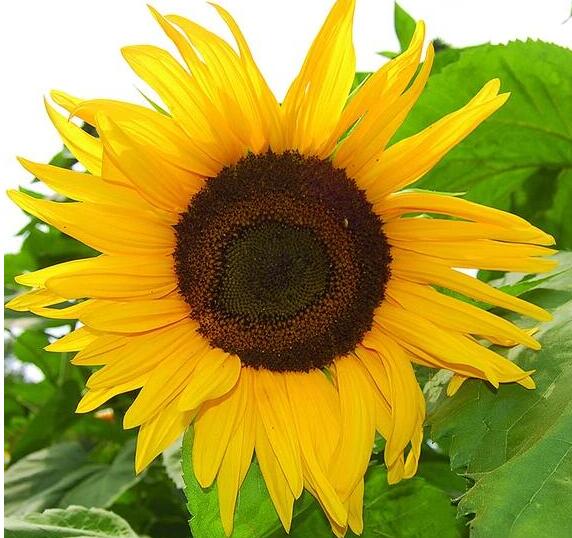
Sunflower Plant Care Guide: Planting, Growing & Caring Tips (8% Cashback)
Sunflower Plant Overview
Sunflower is believed to have been domesticated from wild sunflower around 1000 B.C. in the western U.S. Spaniards brought the sunflower to Europe in 1510, but it was never really viewed as a food plant by Europeans until it reached Russia in the late 1800s. The process of improving sunflower into a modern crop began in Russia around 1860. By the late 1940s, Americans were able to bring back sunflower varieties with oil contents of nearly 50 percent. American varieties at the time had 20 to 30 percent seed oil content.

While they grew abundantly on the Great Plains, sunflowers were first purposely cultivated by Native Americans in the Southwest or Mississippi River valley area as a source of medicine, fiber, seeds, and oil.
Long beloved as part of the rural landscape, sunflowers have been embraced by gardeners as an ornamental plant relatively recently. Responding to this interest, breeders in Germany, Japan, and the U.S. have developed types particularly suitable for home gardens.
Types of Sunflowers
Sunflowers contain both annuals and perennials. Most sunflowers grow strong stems with showy, daisy-shaped flowers in different colors including yellow, orange, red, cream, purple and bronze. Sunflowers reach anywhere from only a few inches to several feet tall.
However, despite popular belief, not all sunflowers grow to be the same size and color. Because of the several different species that occupy the Helianthus genus, we are going to break it down into three groups for you:
Tall Sunflowers: Because of their tall and rough stems, sunflowers can grow to be several feet high. Soaring to as high as 16 feet tall, these giant beauties are always trying to get their vibrant petals closer to the sun. The sunflowers that grow the tallest usually have big single stalks with large brown centers that connect to golden yellow petals. (Tall Perennial Sunflowers & Tall Annual Sunflowers)Dwarf Sunflowers: Dwarf sunflowers are a type of sunflower that grows to heights of only three feet or smaller! They love to grow in gardens and look great in planters when placed in bunches. ( Short Perennial Sunflowers & Short Annual Sunflowers)
Colored Sunflowers: Thanks to hybridizing, sunflowers now come in a variety of colors from creamy custard to deep red wine. They are perfect for adding a pop of color to your garden or home decor.
If you want to get one, don't forget to sign up at Extrabux (What is Extrabux?) , then you can enjoy up to 8% cashback from Extrabux! Sign-Up Bonus: Free to join it & get $20 welcome bonus!
Popular Varieties of Sunflowers
Russian Mammoth
If you're looking for the perfect sunflower to enter in a contest, this is it. With bright gold petals that are pointed at the tips and a height of nine to 12 feet, this sunflower is indeed commanding and their large striped seeds are just one of the many advantages of choosing this flower. The Russian Mammoth lives best in Mediterranean climate and can propagate as early as April.

American Giant
If you choose these types of sunflowers, it is best to plant them separately from other flowers because they can grow as high as 15 feet. Because of its height and the fact that the head can be as wide as 12 inches, there's no wonder this variety has the word “giant” added to its name.

Autumn Beauty
It's a vibrant choice for flower gardens. The bold flowers feature 8-inch wide blooms in bright yellow, bronze and purple combinations. Growing up to 4-feet tall and featuring multiple branches, Autumn Beauty makes an excellent cut flower for floral arrangements. Also known as the common sunflower, the plant has edible flower buds which are delicious when battered and fried. Seeds should be planted 2-inches deep and spaced 18-inches apart.

Sunny Smile
Although considered small by sunflower standards, these bright yellow flowers with yellow-gold centers and pointed tips can grow as wide as six inches and as high as two feet high. Their cheery look makes them stand out and very popular with flower lovers.

Arikara
Sunflower 'Arikara' is an heirloom variety. It was grown as a source of edible seeds by the Arikara tribe of native Americans in North Dakota. Arikara is a very tall variety with large yellow flowers that have black centers. The flowers appear singly or in clusters. The single flowers can grow up to 12-16" in diameter. This tall sunflower adds height to the garden, and the ripening seeds attract birds.

Ms Mars' is a stout, upright, branching annual with purple-flushed leaves, buds and stems, growing to about 60cm. Dark pink to purple flowers and foliage. Naturally dwarf plants with dark foliage and dark purple buds. The flowers are 15cm across with a very dark red centre and rosy pink petals tipped with cream, produced in late summer and early autumn.

How to Care for a Sunflower Plant?
Geography
Sunflowers thrive in all 50 states in the U.S., most blooming during the summer months. Their native range also extends through Canada, Northern Mexico, and Central America. The sunflower's native environment is dry, wide-open spaces such as prairie lands, plains, and meadows. Sunflowers occasionally spring up like a weed in farm fields and pastures. I
Planting Season
It's best to sow sunflower seeds directly into the soil after the danger of spring frost has passed. Ideally, the soil temperature has reached 55 to 60 degrees F (13–16°C). Plant the large seeds no more than 1 inch deep about 6 inches apart after the soil has thoroughly warmed, from mid-April to late May in northern regions-earlier in southern areas. You can plant multiple seeds and thin them to the strongest contenders when the plants are six inches tall. For a longer sunflower bloom period, plant a row or grouping of sunflowers every two weeks for four to six weeks during the early summer.
Where to plant
Sunflowers have long tap roots that need to stretch out, so the plants prefer well-dug, loose, well-draining soil; in preparing a bed, dig down 2 feet in depth and about 3 feet across to ensure the soil isn't too compact. Find a well-drained location, and prepare your soil by digging an area of about 2-3 feet in circumference to a depth of about 2 feet. The amount of space they need depends on which varieties you are growing. Branching types with multiple blooms on one stem need more space horizontally than large single-flowered types.
Sunlight and Temperature
Sunflowers are full sun plants that only thrive in environments in which they are provided six or more hours of direct sunshine per day. The more sun a sunflower gets, the better the growth. If you crowd plants too closely together, the leaves will be starved for sunlight. This causes the plant to grow too quickly and produce weak stems as plants reach up for more light. This annual prefers the longer-lit days of summer and blooms through the season. Sunflowers thrive in warmer weather and climates. They are known for their hardiness and the ability to survive extreme heat.
Water
Water thoroughly at the time of planting and keep the planting area about as moist as a wrung-out sponge (not soggy) while the seeds are sprouting. Most sunflowers are fairly drought-tolerant once established but will bloom better with regular water. To be on the safe side, water sunflowers well when the top two inches of soil are dry.
Sunflower roots spread widely and can withstand some drought. However, it is best to water them regularly during their most important growth period which is about 20 days before and after flowering. Deep, regular watering helps encourage root growth, which is especially helpful with taller sunflower varieties bearing top-heavy blooms.
Sunflowers also withstand wet, humid weather, although well-draining soil or containers are essential in such climates. Sunflowers experience growth problems if they become water-logged.
Soil
The hardiness of the sunflower makes it an adaptable plant that is able to survive in almost any soil conditions, except those that are water-logged. However, the ideal soil environment for sunflower is a well-draining sand or loam mixture. Sunflowers thrive in neutral soils, but they also tolerate slightly acidic to slightly alkaline soils. A pH range of 6.0 to 7.5 is favorable.
Fertilizing
Sunflowers do not require fertilizing. However, because they grow vigorously (they can easily grow 6 feet in just 3 months), it's a good idea to add some slow-acting granular fertilizer to especially poor, thin soil. A month after planting, begin feeding sunflowers with Miracle-Gro® Water Soluble All Purpose Plant Food. The better their diet, the larger the flowers. Do not overdo the nitrogen because that will delay flowering.
Harvesting
In the early fall, check flower heads for signs of maturity. The reverse side turns from green to a yellow-brown. Large heads will nod downward. Cut off the seed heads with a foot or so of stem attached and hang them in a warm, dry place that is well-ventilated and protected from rodents and bugs. When the seeds are thoroughly dried dislodge them by rubbing two heads together, or by brushing them with your fingers or a stiff brush.
Efficient harvest requires a modified grain head on the combine. A standard combine header will cause excessive seed loss to the ground from shattering, so a special sunflower header should be obtained, or a conventional header can be modified by adding catch pans, deflectors and possibly a smaller reel.
If you want to find more deals on Sunflower plants, you can visit these site with up to 8% cashback from Extrabux!
burpee.com(5%)
edenbrothers.com (6%)
homedepot.com (6%)

Extrabux is an international cashback shopping site, offering up to 30% cashback from 10,000+ Stores!
B&H Photo Video, Dyson, Woodland Direct, Ooni UK, Bed Bath and Beyond, TUSHY, Zoro, Anthropologie, 4seating.com, GDF Studio, simplehuman, Appliance Parts Pros, etc.
Join to get $20 welcome bonus now! (How does Welcome Bonus work?)
Recommendation
-

10 Best & Stylish Winter Coats for Women on NET-A-PORTER in 2024
-

Top & Best 12 Sneaker Apps/Websites for Raffles, Releases & Restocks in 2024
-

7 Best Gift Card Exchange Sites - Buy, Sell and Trade Discount Gift Card Safely and Instanly!
-

Top 9 Professional Skincare Brands for Licensed Estheticians 2024
-

13 Best Luxury Online Shopping Sites with Highest Cashback in 2024 (Coupon Code+Sale+14% Cashback)
Up to 14% Cashback!










